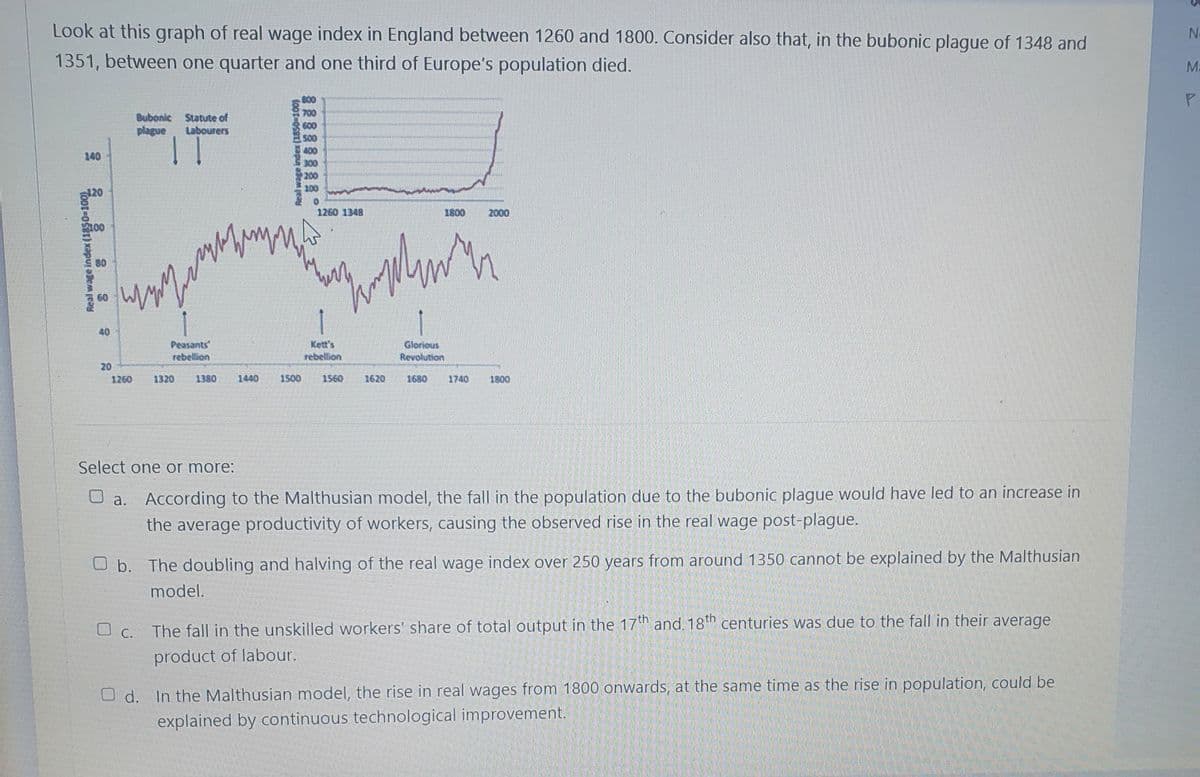300 200 100 1260 1348 1800 2000 Peasants Kett's Glorious rebellion rebellion Revolution 1380 1440 1500 1560 1620 1680 1740 1800 or more: cording to the Malthusian model, the fall in the population due to the bubonic plague would have led to an increase in average productivity of workers, causing the observed rise in the real wage post-plague. e doubling and halving of the real wage index over 250 years from around 1350 cannot be explained by the Malthusian odel. e fall in the unskilled workers' share of total output in the 17th and. 18th centuries was due to the fall in their average Real wage in
300 200 100 1260 1348 1800 2000 Peasants Kett's Glorious rebellion rebellion Revolution 1380 1440 1500 1560 1620 1680 1740 1800 or more: cording to the Malthusian model, the fall in the population due to the bubonic plague would have led to an increase in average productivity of workers, causing the observed rise in the real wage post-plague. e doubling and halving of the real wage index over 250 years from around 1350 cannot be explained by the Malthusian odel. e fall in the unskilled workers' share of total output in the 17th and. 18th centuries was due to the fall in their average Real wage in
Chapter11: Labor Markets
Section: Chapter Questions
Problem 3SQP
Related questions
Question

Transcribed Image Text:Look at this graph of real wage index in England between 1260 and 1800. Consider also that, in the bubonic plague of 1348 and
1351, between one quarter and one third of Europe's population died.
M.
Bubonic Statute of
plague
Labourers
140
100
1260 1348
1800
2000
100
40
Kett's
rebellion
Peasants
Glorious
Revolution
rebellion
20
1260
1320
1380
1440
1500
1560
1620
1680
1740
1800
Select one or more:
O a. According to the Malthusian model, the fall in the population due to the bubonic plague would have led to an increase in
the average productivity of workers, causing the observed rise in the real wage post-plague.
O b. The doubling and halving of the real wage index over 250 years from around 1350 cannot be explained by the Malthusian
model.
O C. The fall in the unskilled workers' share of total output in the 17th and. 18th centuries was due to the fall in their average
product of labour.
O d. In the Malthusian model, the rise in real wages from 1800 onwards, at the same time as the rise in population, could be
explained by continuous technological improvement.
Expert Solution
This question has been solved!
Explore an expertly crafted, step-by-step solution for a thorough understanding of key concepts.
Step by step
Solved in 2 steps

Knowledge Booster
Learn more about
Need a deep-dive on the concept behind this application? Look no further. Learn more about this topic, economics and related others by exploring similar questions and additional content below.Recommended textbooks for you



Principles of Economics 2e
Economics
ISBN:
9781947172364
Author:
Steven A. Greenlaw; David Shapiro
Publisher:
OpenStax



Principles of Economics 2e
Economics
ISBN:
9781947172364
Author:
Steven A. Greenlaw; David Shapiro
Publisher:
OpenStax

Principles of Microeconomics
Economics
ISBN:
9781305156050
Author:
N. Gregory Mankiw
Publisher:
Cengage Learning

Exploring Economics
Economics
ISBN:
9781544336329
Author:
Robert L. Sexton
Publisher:
SAGE Publications, Inc

Principles of Microeconomics (MindTap Course List)
Economics
ISBN:
9781305971493
Author:
N. Gregory Mankiw
Publisher:
Cengage Learning